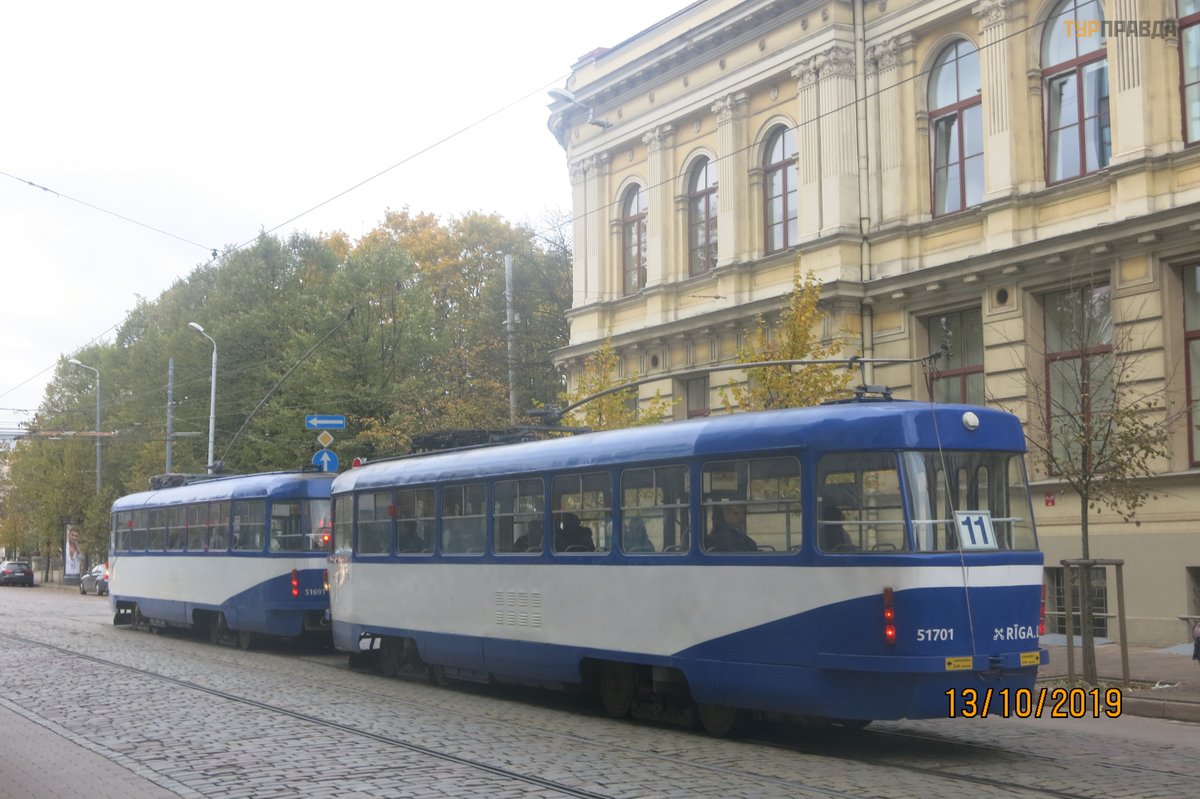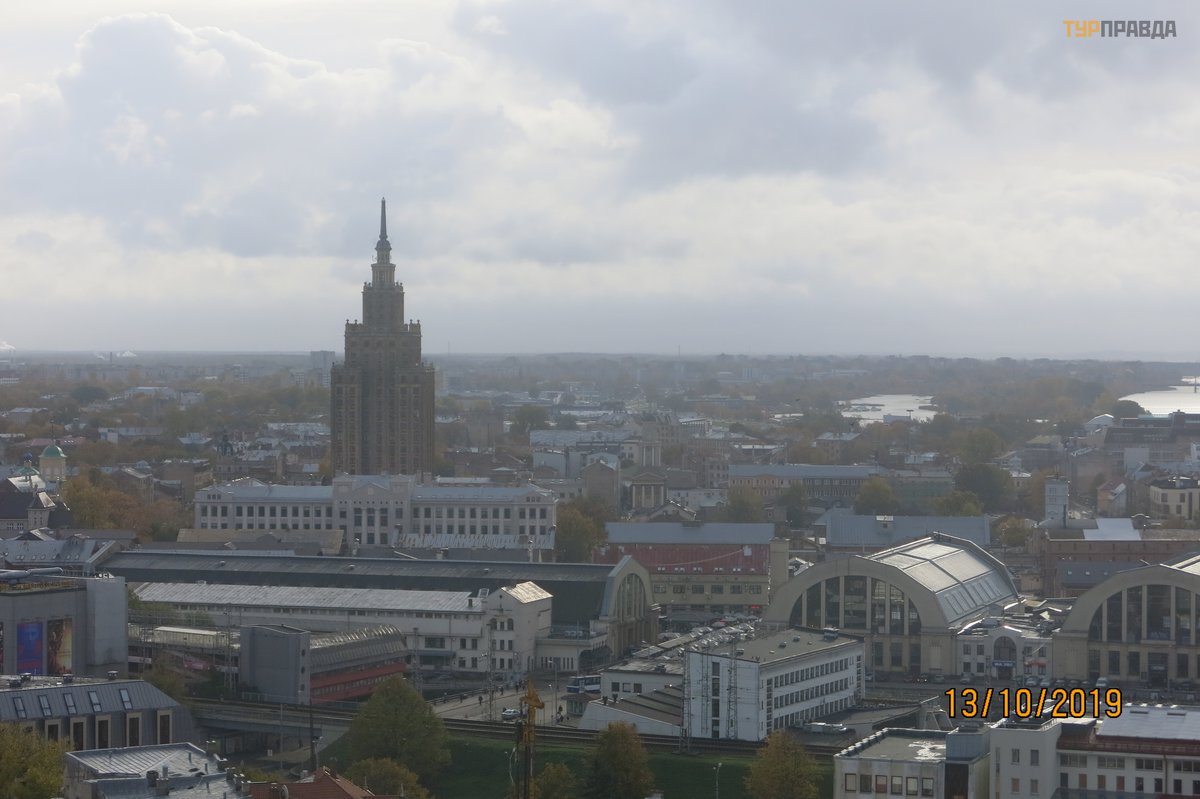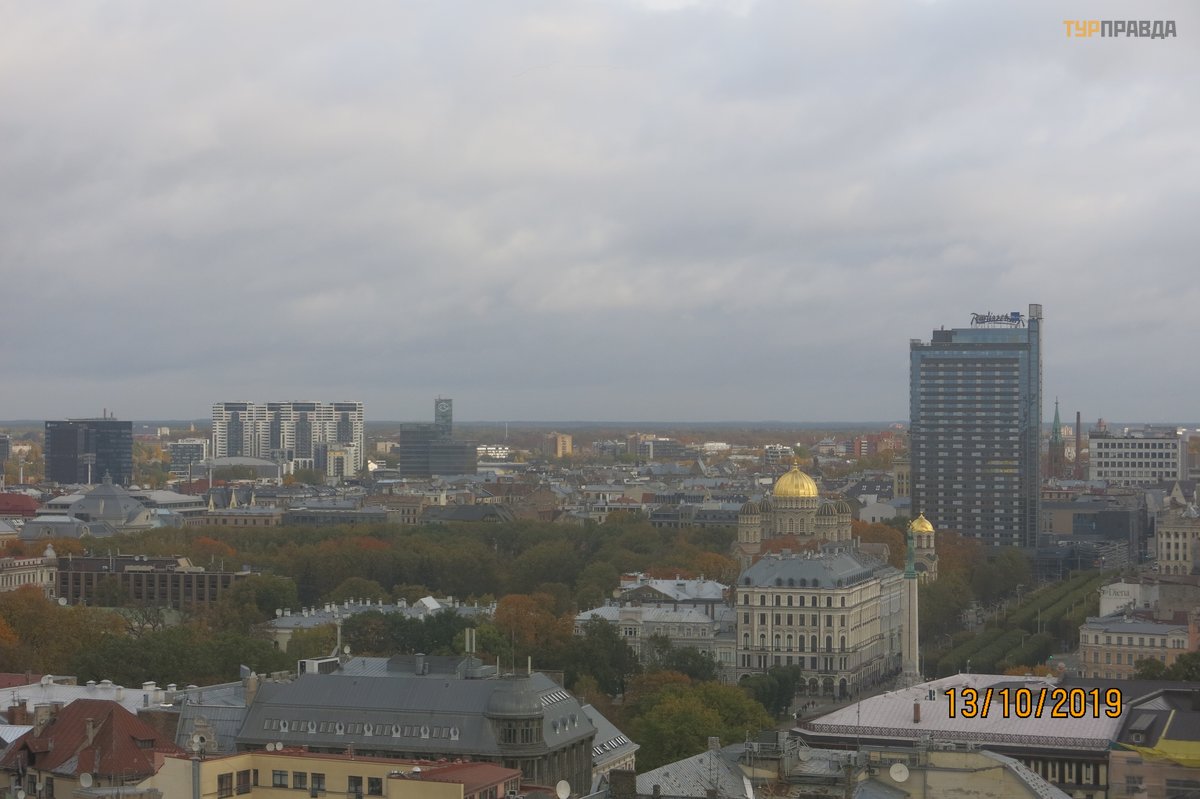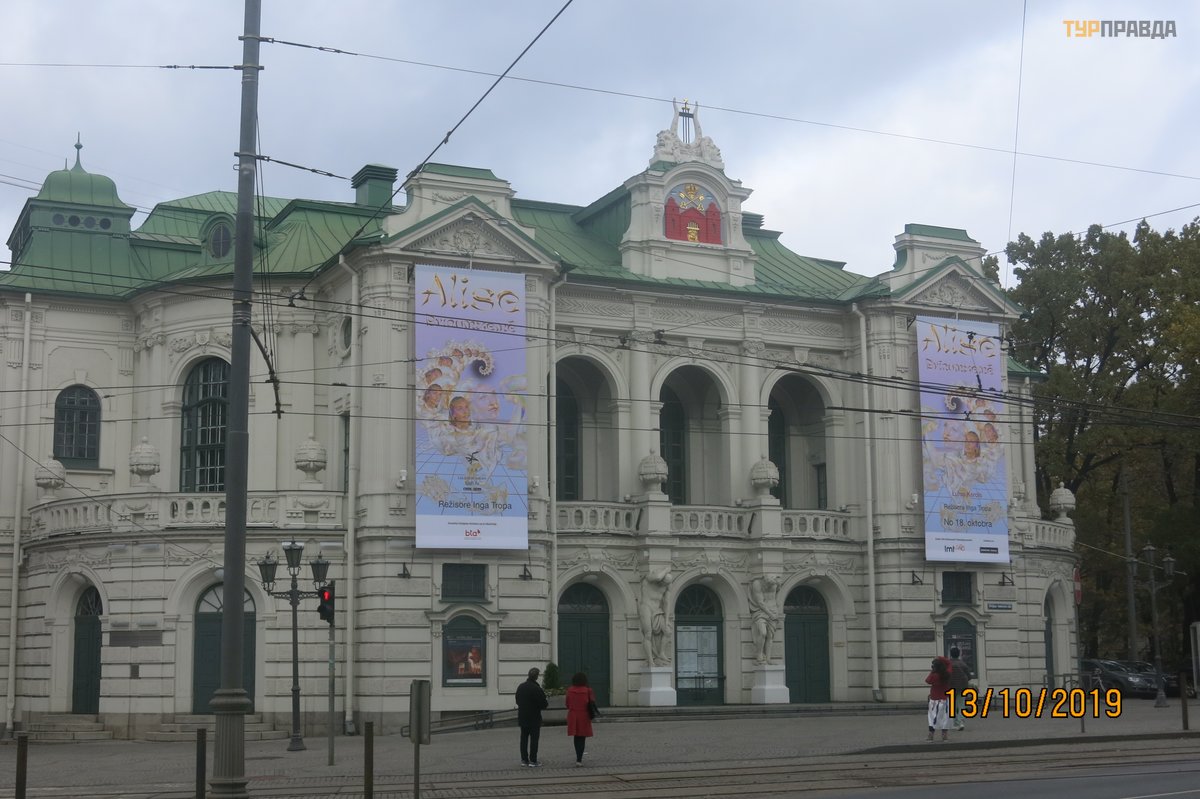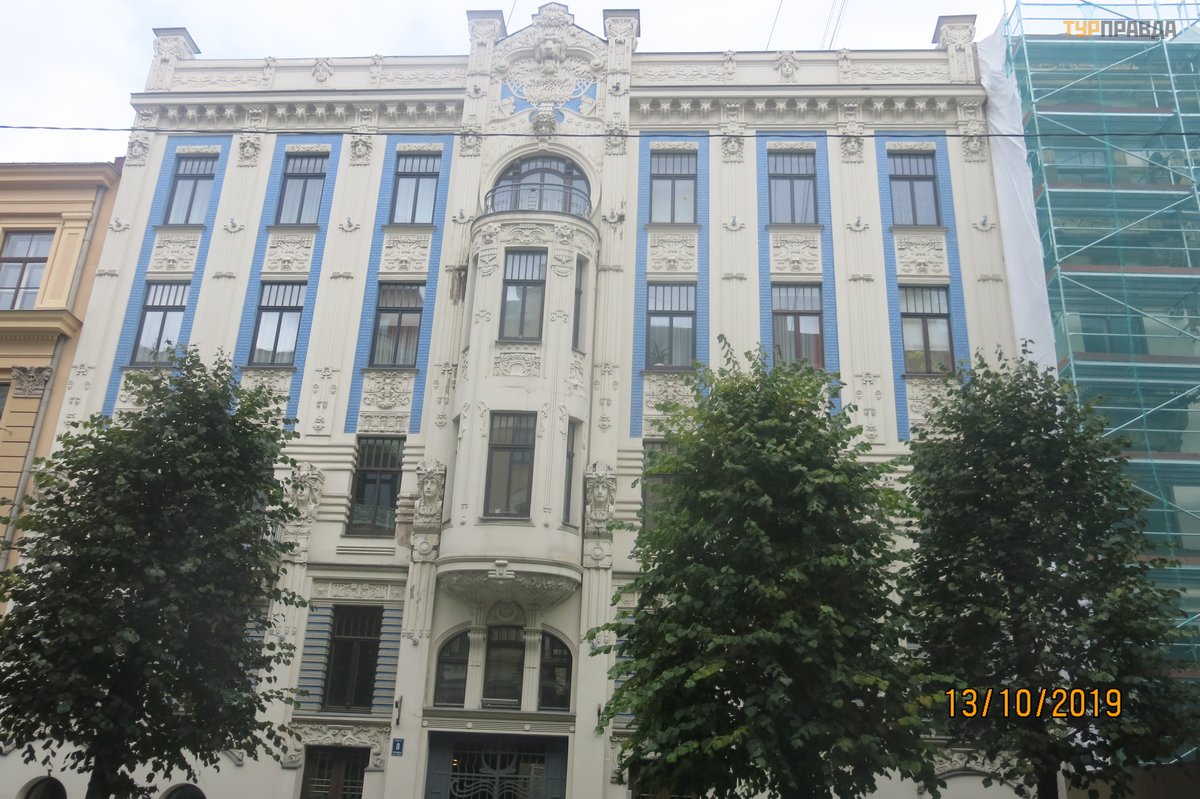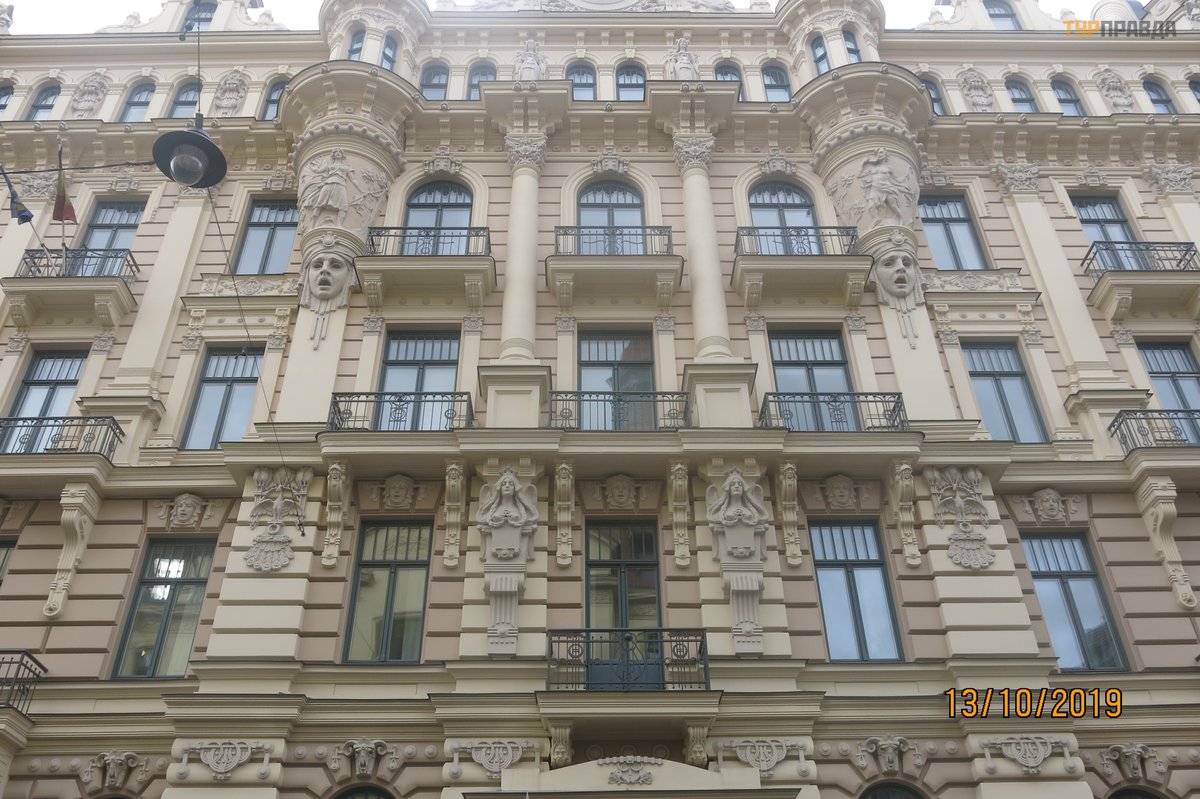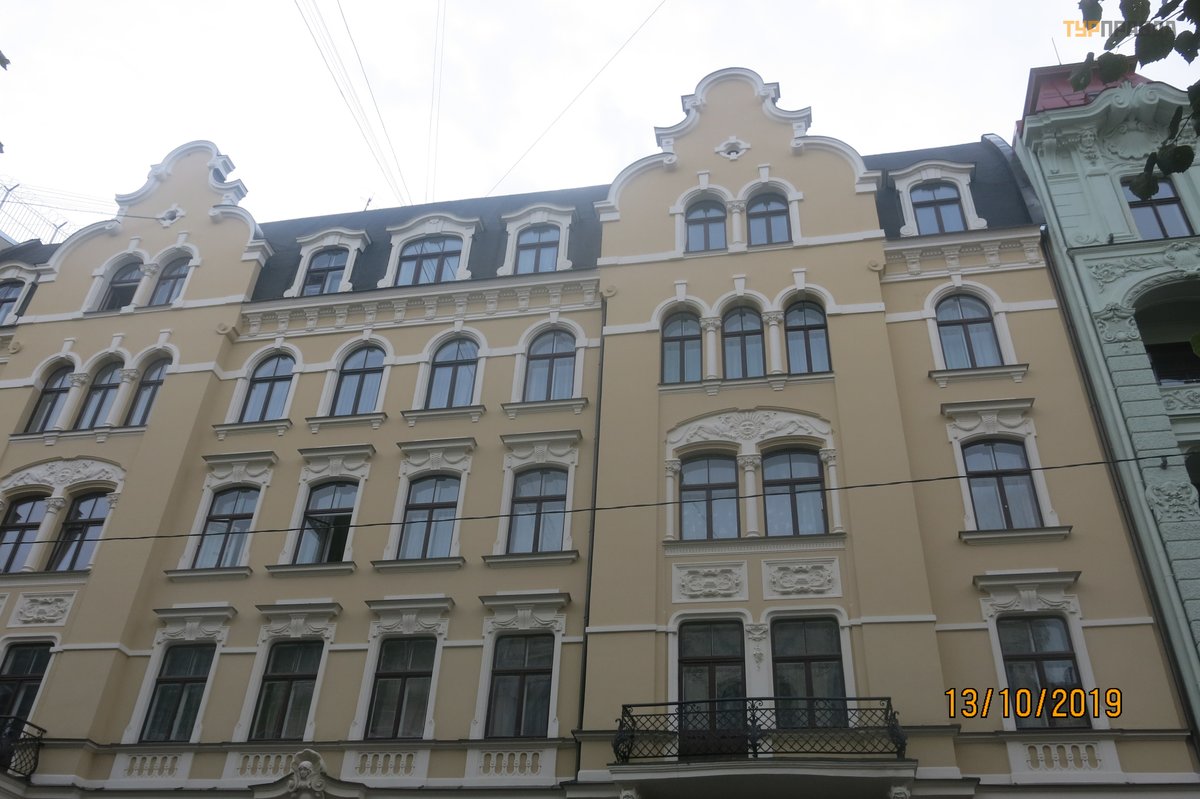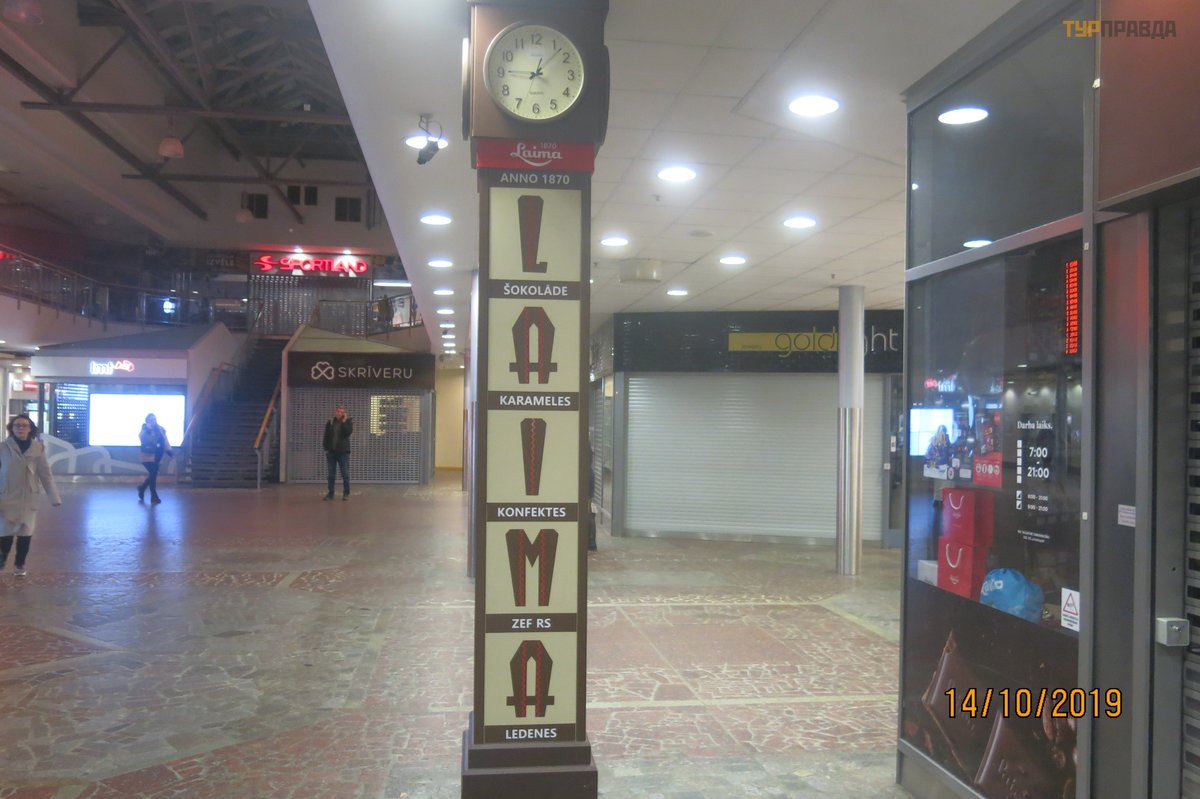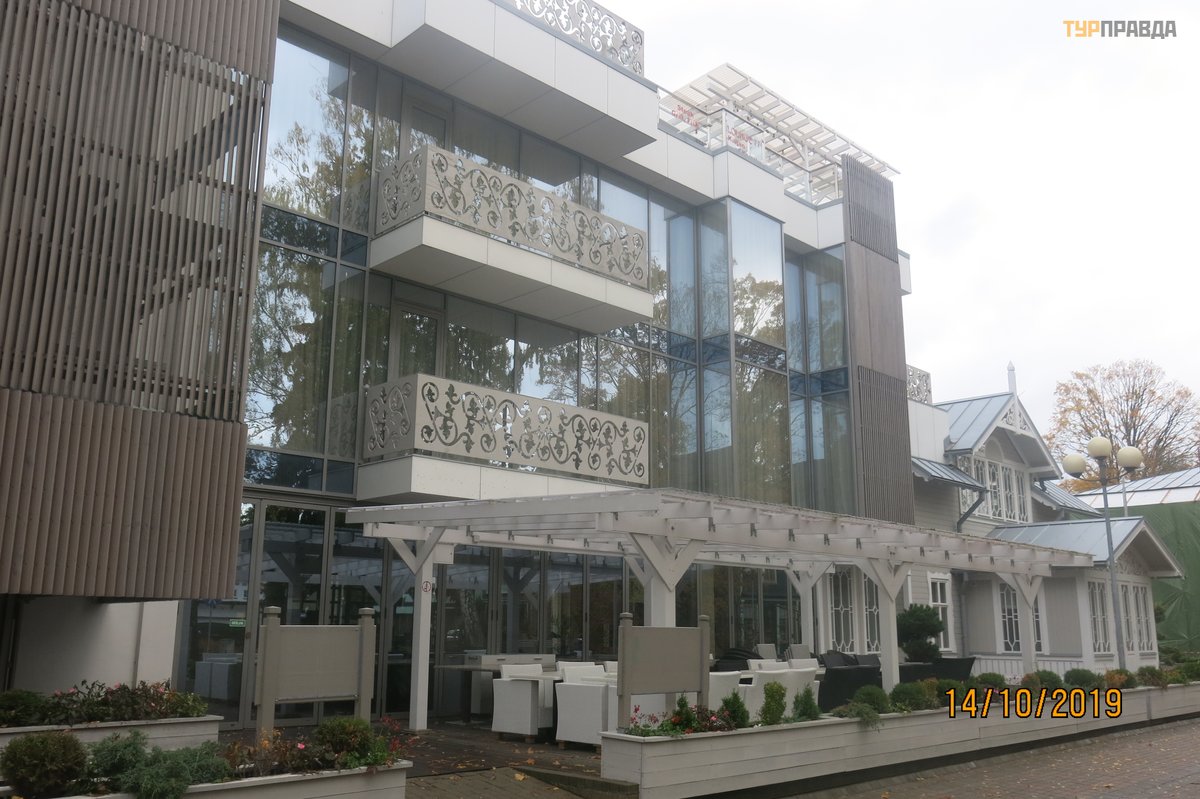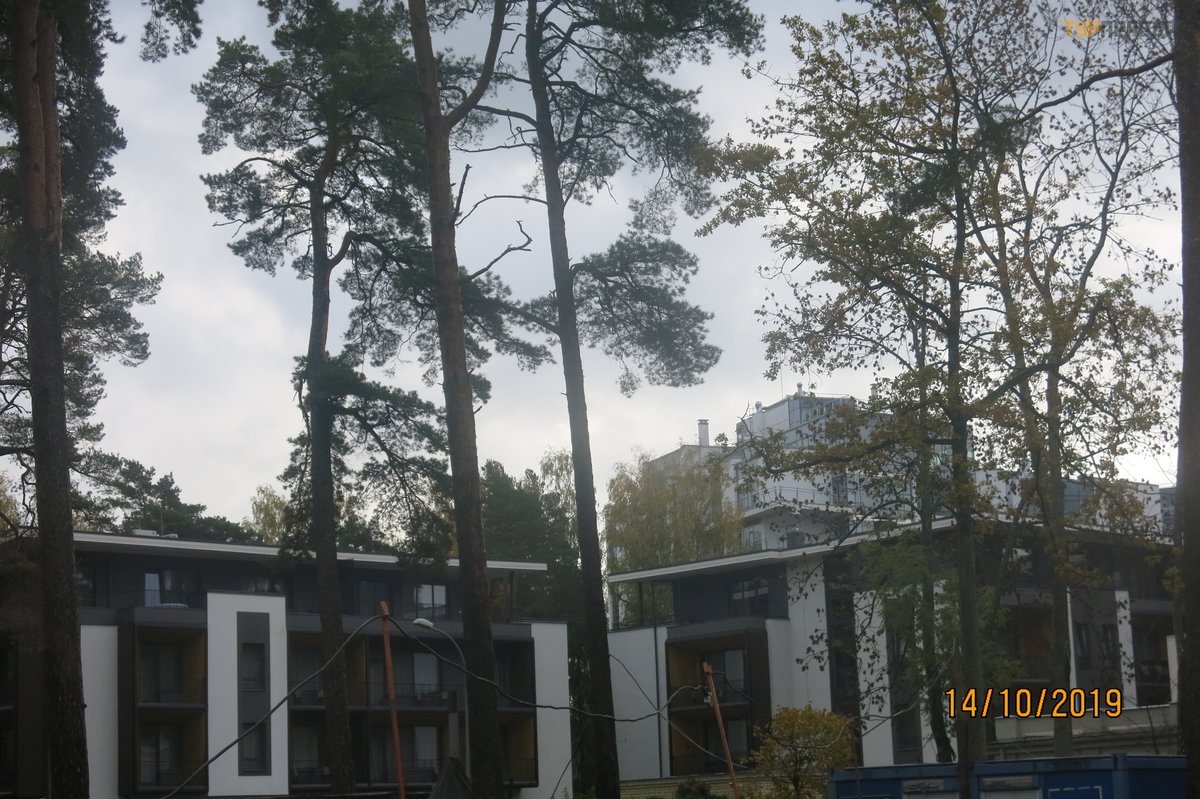Baltic autumn. Part 1.
When planning the trip, I initially expected 3 nights (2.5 days) in Latvia and 5 nights (4 days) in Estonia, but due to changes in the Wizzair flight schedule (departure time from 11:25 to 22:30) I had to depart at 15 : 15 by another airline (AirBaltic). As for AirBaltic, the price is too high compared to Wizzair. The service is about the same. Flying a liner "de Havilland" (about 50 passengers), very close and very noisy, the peculiarity of the design of the wings of this is that in all places behind the wing will be very limited view. They were 10 minutes late at the Riga airport. They crossed the border without any problems, the border guards asked only about the purpose of the trip (tourism), they did not ask for any documentary evidence.
Immediately after leaving the airport terminal, I start looking for a bus stop №22, which goes to the city center and "R-kiosk", where you can buy tickets for it.
I find a kiosk (it's just opposite the stop) - a small trade pavilion, where in addition to tickets for public transport, drinks and snacks, also sells very chic and expensive bouquets of flowers (about € 20). The cost of a ticket for one trip is € 1.15. Buses run at intervals of about 20 minutes. First we go through the fields, then the suburban area begins. The outskirts of the city begin, not as we are accustomed to, with arrays of new buildings, but with the old 2-3-storey buildings of the first half of the twentieth century. , in some places even wooden, new houses are also available, but on the other side of town.
Bus stops are frequent, a lot of people come in / out, everyone has valid season tickets, one-time tickets, like ours, no one has. And here is the Daugava embankment, the bus crosses the old bridge to the other bank (by the way, both banks of the Daugava are flat), we get off at the second stop (near the central railway station), but from the central market.
Next on the modern, but deserted and a bit scary underpass (by the way, not suitable for transporting luggage on wheels) - abandoned empty shops, suspicious companies, we get to the hotel.
Ria Irina Hotel, in principle, normal (106 euros / 3 nights / twin), breakfast is good, to the historic center 15 minutes on foot. The only problem is noisy, the windows overlook a fast intersection. City buses and trolleybuses stop right in front of the hotel. After settling in, we visit the Origo shopping center (adjacent to the station) and the expensive Stockman department store (Finnish network, everything is very expensive, there are no buyers at all). It is too late to go to the historic center.
On the second day after breakfast we go to the historic center. The Circus building is located on our street Mekela iela a few houses away.
Very modest in size, the dome is almost invisible from the street, the circus building does not stand alone, but is built into the quarter. Surprisingly, at every step there are currency exchange offices, pawnshops and slot machine halls (almost like ours). We return to the street Krisjanis Baron, here we meet the first Riga, in my opinion, interesting - Riga tram. As you know, in Riga there is a machine-building plant that produces rolling stock of trams and electric suburban trains (the latter were operated throughout the former Soviet Union). But not everything is so simple with trams: locally produced trams of different years and different modifications run through Riga, but they all have a colorful local feature - they use a trolleybus bar instead of a folding pantograph as a current collector! Of course, with a rope.
I have never seen such trams anywhere else in Europe.
Here begins the ancient center, houses of the late 19th - early 20th centuries. In particular, the building of the Academy of Music (conservatory) flashed to the left. Immediately after it begins Bastejkalna Park, which crosses a small long body of water, called the City Canal. Motor and merry boats sail slowly through the canal. The Riga Opera House (a very monumental building) was built between the park and Old Riga.
And across the road is the medieval center, a pedestrian zone covered with cobblestones. Many boutiques, expensive hotels, Narvesen shops (water, snacks, sweets, souvenirs, all for tourists and not cheap). Sunday morning, many more are closed. Many Dzintars perfume shops and Riga Balzams perfume shops from different countries (real Riga Balzams liqueurs in clay containers of various capacities occupy a very modest place).
Finally we come to St. Peter's Basilica, famous for its observation deck on the tower.
The Cathedral will host a morning service (the hall where the service will be held, separated by a sliding glass door). Admission is free, but the minister of the cathedral notes that it is impossible to leave until the end of the service (end in an hour and a half). We decide to go to the tower. This can be done: on foot on a spiral staircase or in an elevator. In both cases, the cost of the visit is 9 euros. In the lobby in front of the elevator (if this place is so called) an exhibition dedicated to the 30th anniversary of the action "Baltic Way" 600 km attracted attention. In a few minutes the elevator lifts us to a height of 72 m, where there is an observation deck (the total height of the cathedral with a spire - 124 m).
From here - the whole of Riga in the palm of your hand, you can see up to the arrays of new buildings in the east of the city. And the historic center just below us seems at arm's length.
On the opposite side of the Daugava is the so-called City district, which is dominated by the modern 92-meter building of Swedbank in the shape of an iceberg. The left and right banks of the city are connected by 5 bridges. The most famous of them are the Stone Bridge (built in 1957, so named because the lanterns on the bridge are built on high granite floor lamps and the bridge on the waterfront are also built granite stairs) and the Cable Bridge (built in 1979, originally called "Kyiv bridge ", as its design was developed at the Kiev Institute" Ukrshlyakhproekt ", the design of this bridge is very similar to the design of the North Bridge in Kiev).
Immediately behind the Cable-stayed Bridge (the last in the city by the sea) is the Port of Riga, where a passenger-cargo ferry (probably from Stockholm) was moored at that time.
To the right is the area of railway stations (bus and bus), behind which the central city market, and then the 20-storey building of the Latvian Academy of Sciences, built in the style of "socialist realism" (1958) with a spire, but without a star. The next object of visit is the House (Kamyanytsia) of the Blackheads. It is located on the Town Hall Square (opposite the Riga City Hall) and is a stone building with two entrances.
 House of the Brotherhood (Order) of the Blackheads
House of the Brotherhood (Order) of the Blackheads
The House of the Blackheads is the home of a guild of merchants, mostly of German origin, who in the Middle Ages were engaged in the supply of goods to Riga from around the world.
The patron saint of the guild is St. Maurice, a native of Africa, black. The very image of his head was a symbol of the guild. The guild building was built in the 14th century.
, destroyed during the Second World War, restored according to descriptions, photos and drawings in 1996. At present, the House of the Blackhead houses an exhibition of medieval objects, the hours of the Guild's existence, all the rooms of the building are decorated in the style of the Middle Ages. Entrance 6 euros, the entrance to the queue of tourists did not come.
Just from the square, next to the building of the Riga Technical University - a strict building of beige color, built approximately in 1940-1950, without any decorative elements.
We go to the waterfront. Buildings along the waterfront of different ages, from the mid-19th century. to modern. But built thoughtfully, without vulgarity, while maintaining height.
"Suddenly" from the inter-building space flashed the Dome Cathedral, in my opinion, one of the most beautiful buildings in the city.
It was not possible to visit, because according to the clerk, a service will also be held in the cathedral and it will be possible to come in only 2 hours. Immediately behind the cathedral is the Dome Square with (almost traditional for Riga) houses of various styles.
Wandering further through the streets of the Old Town (past the architectural ensemble "Three Brothers" - 14-17 centuries) ...
 " Three Brothers ". Difference between older and younger - over 200 years
" Three Brothers ". Difference between older and younger - over 200 years
...we go to the square. Pils (Castle Square) to the little-known in tourist circles of Riga Castle.
Part of the castle is occupied by the Riga Museum of Local Lore, and part - the residence of the President of Latvia.
 Residence of the President of Latvia
Residence of the President of Latvia
After a short rest near the small square opposite, we go to the "Museum of Art Nouveau in the open air" - on the street Alberta. The path first passes through the street Kr. Valdemara past the Latvian National Theater (rather modest in appearance - the Latvian National Opera looks much larger) ...
...Latvian Academy of Arts ...
...and the Latvian State Art Museum.
After turning to Elizabets Street, modern business centers and embassies of foreign countries begin (the former are already in little harmony with antiquity - it is clear that this is no longer a historic center, and the center is very meticulous). Finally, Alberta Street, it's hard to comment here, you just have to look:
After a short rest on the benches (they were probably prudently set up for tourist photographers), we return to the city center on Dzirnavu Street (parallel to Elizabets Street). The urban architectural color is complemented by wooden houses (residential! ) And combined wood and stone. On the street.
Dzirnavu like nowhere else in the city, clusters of liquor stores and restaurants of ethnic cuisine (Georgian, Armenian, Uzbek). Ukrainian is not represented: - (Our next goal is a large shopping center Galleria Riga, on the top floor of which we have lunch in a cafe of Latvian cuisine. "Not impressed… A little whispered.
Then we return from Elizabeth Street to the street already mentioned at the beginning of the story.
Christian Baron, and then to our street Merkela iela (literally translated as "starfish street", perhaps actually translated in some other way than some idiom). After a short rest in the hotel we plan to visit another interesting object of Riga, in my opinion, very controversial. We are talking about the central city market of Riga.
Located behind the train station, there are five large stationary hangars and many small tents and pavilions in the surrounding area. Impressions, honestly, negative. Probably because they arrived there too late (it was about 16:00) - the sellers were already starting to close. The culture of service is very low, sellers are very obsessive, many of them are intoxicated, communicate with each other using profanity. But the prices are at the level of H&M, but the quality is much lower: - (.
The next day after breakfast we go to Jurmala.
Trains from the central station depart every hour, the duration of the trip is 30 minutes, the cost of tickets is 1.05 euros there and 1.40 euros ago (for flights in the morning there is a discount). Riga Central Station made a very depressing impression - many drunk, homeless, beggars and other suspects: - (.
The only positive thing I remember at the station is a mini-copy of the Riga watch "Laima" (from Latvian translated as "happiness"):
We leave Jurmala at Majori station (Jurmala station as such does not exist, Majori and Dzintari stations are located in the city center. Almost immediately from the station begins the central pedestrian promenade, Jomas street. The surrounding architecture can be divided into three parts: wooden resort houses country look, now mostly empty (mid-autumn is no longer the season) ...
stone 2-, 3-storey buildings (most likely, residential and apartment) ...
...built in the first half of the twentieth century. with souvenir and clothing stores on the ground floors, modern 2-, 3-storey buildings (some built in the old days, some - no), some of them are mini-hotels.
About 200 m from the station there is a small shopping center Korso with a supermarket (the length of Jomas Street is about 1.3 km), no more supermarkets were seen, only cafes and restaurants, there is also a small market, mostly souvenirs. Approximately in the middle of the street is the large 4-star Hotel Jurmala SPA, large stationary hotels of the 1960s-1980s are not visible.
Jomas ends near Dzintari Central Park, where Jurmala's business card is located - the open-air concert hall of the same name and a shell-shaped stage.
It's not the season at the moment, it's closed, so we managed to take pictures only through the gate. In one of the cafes we have lunch on the menu of the day (soup, potatoes, salad, minced meat chop, juice - for only 7 euros). We go down to the sea. Sandy beach, very wide.
Lots of shops.
Every 200-300 meters there are small cafes, in good weather - with open verandas. It was sunny that day and then cloudy, but windy all day. Of course, no one bathes, everyone breathes the sea, some feed numerous seagulls. Towards evening we return to the beach towards Majori. We pass a concrete house of interesting shape - it turns out it is a hydrometeorological station.
Already in Majori we notice just above the beach 5-star Baltic Beach Hotel, reminiscent of the shape of a ship.
Given that it is already dusk, and the hotel has only no more than 10% of windows, I conclude that the hotel is almost empty. There is a large metal turtle near the hotel, with which tourists are photographed. The turtle is a symbol of slowness and slowness, such is the rest in Jurmala - slow and slow, active entertainment, at least in autumn, is invisible here. Well, everyone has their own type of recreation.
The day of eviction has come. The bus is with us at 11:30. A last look at the sharp classics ...
...and to the bus station.
Luxexpres bus with free Wi-Fi, coffee and tea machine, but paid bottled water. There is a screen in the front of the chair, where you can watch movies (but how to choose and configure them - I did not understand).
You can connect to the Internet through the same screen, football sites were downloaded, and it was not possible to watch the video of yesterday's match Ukraine-Portugal - it was reported that this content is protected by copyright: - (.
An hour near the road between Riga and Tallinn - 4 hours 35 minutes, about half - in each of the countries. Views in Latvia - mostly forested, the road will pass away from settlements without stopping. At one of the junctions saw a turn on the m.
Cesis and the sculpture of Munchausen at the core (in Cesis, according to legend, his estate, and now a museum). For some hours the route runs along the coast, and on the border with Estonia we pass through a small bay, where the famous fish cannery "Brivais Vilnis".

